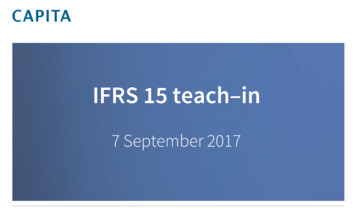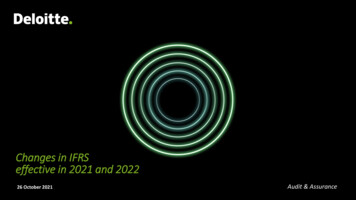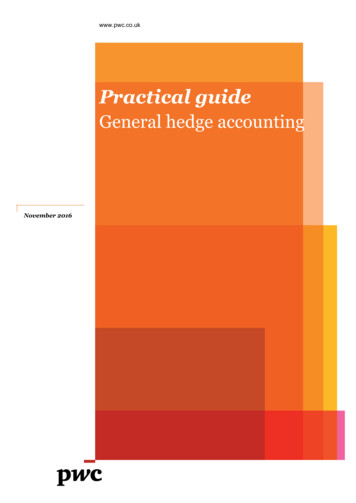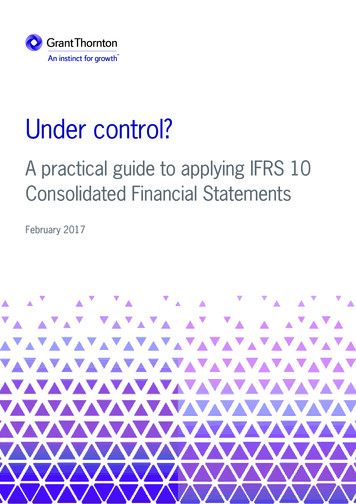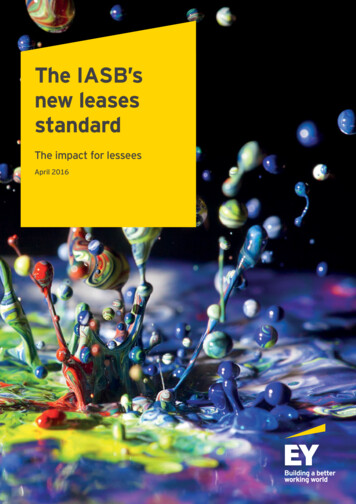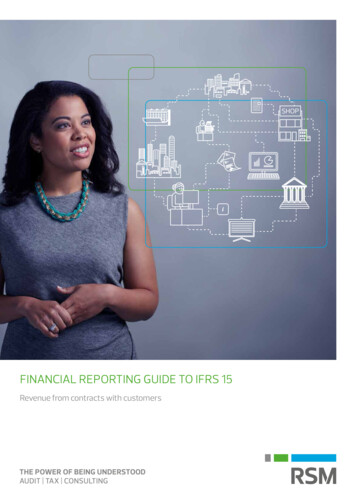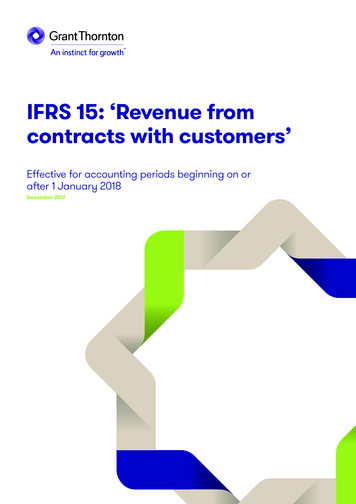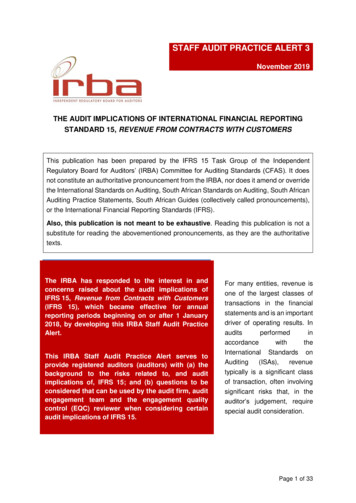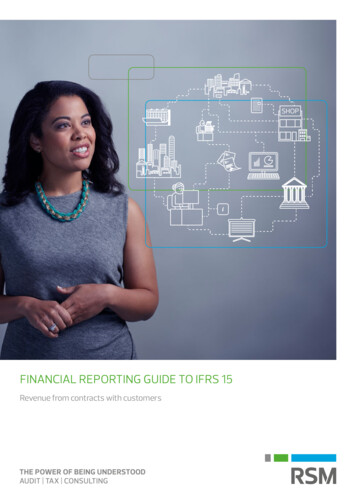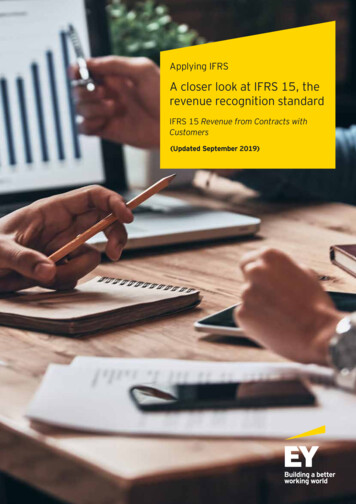
Transcription
Applying IFRSA closer look at IFRS 15, therevenue recognition standardIFRS 15 Revenue from Contracts withCustomers(Updated September 2019)
OverviewThe largely converged revenue standards, IFRS 15 Revenue from Contractswith Customers and Accounting Standards Codification (ASC) 606, Revenuefrom Contracts with Customers1 (together with IFRS 15, the standards), thatwere issued in 2014 by the International Accounting Standards Board (IASBor the Board) and the US Financial Accounting Standards Board (FASB)(collectively, the Boards) provide accounting requirements for all revenuearising from contracts with customers. They affect all entities that enter intocontracts to provide goods or services to their customers, unless the contractsare in the scope of other IFRSs or US GAAP requirements, such as thosefor leases. The standards, which superseded virtually all legacy revenuerequirements in IFRS and US GAAP, also specify the accounting for costsan entity incurs to obtain and fulfil a contract to provide goods or services tocustomers (see section 9.3) and provide a model for the measurement andrecognition of gains and losses on the sale of certain non-financial assets, suchas property, plant or equipment (see section 2.2.1).As a result, entities that adopted the standards often found implementation tobe a significant undertaking. This is because the standards require entities tomake more judgements and estimates and they affect entities’ financialstatements, business processes and internal controls over financial reporting.Following issuance of the standards, the Boards created the Joint TransitionResource Group for Revenue Recognition (TRG) to help them determinewhether more application guidance was needed on the standards. TRGmembers include financial statement preparers, auditors and other users froma variety of industries, countries, as well as public and private entities.Members of the joint TRG met six times in 2014 and 2015, and members of theFASB TRG met twice in 2016.TRG members’ views are non-authoritative, but entities should consider them asthey implement the standards. In its July 2016 public statement, the EuropeanSecurities and Markets Authority (ESMA) encouraged issuers to considerthe TRG discussions when implementing IFRS 15.2 Furthermore, the formerChief Accountant of the US Securities and Exchange Commission (SEC)encouraged SEC registrants, including foreign private issuers (that may reportunder IFRS), to consult with his office if they are considering applying thestandard in a manner that differs from the discussions in which TRG membersreached general agreement.3We have incorporated our summaries of topics on which TRG members generallyagreed throughout this publication. Unless otherwise specified, these summariesrepresent the discussions of the joint TRG. Where possible, we indicate ifmembers of the IASB or its staff commented on the FASB TRG discussions.This publication summarises the IASB’s standard (including all amendments)and highlights significant differences from the FASB’s standard. It alsoaddresses topics on which the members of the TRG reached general agreementand discusses our views on certain topics.123Throughout this publication, when we refer to the FASB’s standard, we mean ASC 606(including the recent amendments), unless otherwise noted.ESMA Public Statement: Issues for consideration in implementing IFRS 15: Revenue fromContracts with Customers, issued 20 July 2016, available on ESMA's website.Speech by Wesley R. Bricker, 5 May 2016. Available on the SEC’s website.Updated September 2019A closer look at IFRS 15, the revenue recognition standard2
While entities have adopted the standards, application issues may continue toarise. Accordingly, the views we express in this publication may evolve asadditional issues are identified. The conclusions we describe in our illustrationsare also subject to change as views evolve. Conclusions in seemingly similarsituations may differ from those reached in the illustrations due to differencesin the underlying facts and circumstances. Please see ey.com/IFRS for our mostrecent revenue publications.3Updated September 2019A closer look at IFRS 15, the revenue recognition standard
ContentsOverview . 21. Objective, effective date and transition . 71.1 Overview of the standard . 71.2 Effective date . 81.3 Transition methods . 82. Scope . 372.1 Scope of IFRS 15. 372.2 Other scope considerations . 392.3 Definition of a customer. 412.4 Collaborative arrangements . 422.5 Interaction with other standards . 433. Identify the contract with the customer . 543.1 Attributes of a contract . 553.2 Contract enforceability and termination clauses . 643.3 Combining contracts. 713.4 Contract modifications . 733.5 Arrangements that do not meet the definition of a contract under thestandard . 864. Identify the performance obligations in the contract. 894.1 Identifying the promised goods or services in the contract . 894.2 Determining when promises are performance obligations. 1014.3 Promised goods or services that are not distinct . 1284.4 Principal versus agent considerations . 1294.5 Consignment arrangements . 1494.6 Customer options for additional goods or services . 1494.7 Sale of products with a right of return . 1645. Determine the transaction price . 1665.1 Presentation of sales (and other similar) taxes . 1685.2 Variable consideration . 1695.3 Refund liabilities . 1915.4 Rights of return . 1925.5 Significant financing component . 1975.6 Non-cash consideration . 2135.7 Consideration paid or payable to a customer. 2175.8 Non-refundable upfront fees . 2265.9 Changes in the transaction price . 2306. Allocate the transaction price to the performance obligations . 2316.1 Determining stand-alone selling prices . 2316.2 Applying the relative stand-alone selling price method . 2486.3 Allocating variable consideration . 251Updated September 2019A closer look at IFRS 15, the revenue recognition standard4
6.4 Allocating a discount . 2566.5 Changes in transaction price after contract inception . 2606.6 Allocation of transaction price to components outside the scope ofIFRS 15 . 2637. Satisfaction of performance obligations . 2657.1 Performance obligations satisfied over time . 2667.2 Control transferred at a point in time . 3047.3 Repurchase agreements . 3127.4 Consignment arrangements . 3197.5 Bill-and-hold arrangements . 3207.6 Recognising revenue for licences of intellectual property . 3247.7 Recognising revenue when a right of return exists . 3247.8 Recognising revenue for customer options for additional goods orservices . 3247.9 Breakage and prepayments for future goods or services . 3258. Licences of intellectual property . 3298.1 Identifying performance obligations in a licensing arrangement . 3308.2 Determining the nature of the entity’s promise in granting a licence . 3378.3 Transfer of control of licensed intellectual property. 3438.4 Licence renewals. 3488.5 Sales-based or usage-based royalties on licences of intellectual property . 3499. Other measurement and recognition topics . 3629.1 Warranties. 3629.2 Onerous contracts . 3709.3 Contract costs . 37210. Presentation and disclosure. 40110.1 Presentation requirements for contract assets and contract liabilities . 40210.2 Presentation requirements for revenue from contracts with customers . 41110.3 Other presentation considerations . 41310.4 Disclosure objective and general requirements. 41410.5 Specific disclosure requirements . 41510.6 Transition disclosure requirements . 43210.7 Disclosures in interim financial statements . 432Appendix A: Extract from EY’s IFRS Disclosure Checklist . 433Appendix B: Illustrative examples included in the standard and references in thispublication . 442Appendix C: TRG discussions and references in this publication . 446Appendix D: IFRS IC discussions and references in this publication. 449Appendix E: Defined terms. 451Appendix F: Changes to the standard since issuance . 452Appendix G: Summary of important changes to this publication . 453Appendix H: Summary of differences from US GAAP. 4565Updated September 2019A closer look at IFRS 15, the revenue recognition standard
What you need to know IFRS 15 provides a single source of revenue requirements for all entities inall industries. It represents a significant change from legacy IFRS. IFRS 15 applies to revenue from contracts with customers and replacedall of the legacy revenue standards and interpretations in IFRS, includingIAS 11 Construction Contracts, IAS 18 Revenue, IFRIC 13 CustomerLoyalty Programmes, IFRIC 15 Agreements for the Construction of RealEstate, IFRIC 18 Transfers of Assets from Customers and SIC-31 Revenue– Barter Transaction involving Advertising Services. IFRS 15 is principles-based, consistent with legacy revenue requirements,but provides more application guidance. The lack of bright lines requiresincreased judgement. The standard may have had little effect on some entities, but may haverequired significant changes for others, especially those entities for whichlegacy IFRS provided little application guidance. IFRS 15 also specifies the accounting treatment for certain items nottypically thought of as revenue, such as certain costs associated withobtaining and fulfilling a contract and the sale of certain non-financialassets.Updated September 2019A closer look at IFRS 15, the revenue recognition standard6
1. Objective, effective date and transition1.1 Overview of the standardThe revenue standards the Boards issued in May 2014 were largely convergedand superseded virtually all legacy revenue recognition requirements in IFRSand US GAAP, respectively. The Boards’ goal in joint deliberations was todevelop revenue standards that:4 Remove inconsistencies and weaknesses in the legacy revenue recognitionliterature Provide a more robust framework for addressing revenue recognition issues Improve comparability of revenue recognition practices across industries,entities within those industries, jurisdictions and capital markets Reduce the complexity of applying revenue recognition requirements byreducing the volume of the relevant standards and interpretations Provide more useful information to users through expanded disclosurerequirementsThe standards provide accounting requirements for all revenue arising fromcontracts with customers. They affect all entities that enter into contracts toprovide goods or services to their customers, unless the contracts are in thescope of other IFRSs or US GAAP requirements, such as those for leases. Thestandards also specify the accounting for costs an entity incurs to obtain andfulfil a contract to provide goods or services to customers (see section 9.3) andprovide a model for the measurement and recognition of gains and losses onthe sale of certain non-financial assets, such as property, plant or equipment(see section 2.2.1).IFRS 15 replaced all of the legacy revenue standards and interpretationsin IFRS, including IAS 11 Construction Contracts, IAS 18 Revenue,IFRIC 13 Customer Loyalty Programmes, IFRIC 15 Agreements for theConstruction of Real Estate, IFRIC 18 Transfers of Assets from Customersand SIC-31 Revenue – Barter Transactions Involving Advertising Services.5After issuing the standards, the Boards have issued converged amendments oncertain topics (e.g., principal versus agent considerations) and differentamendments on other topics (e.g., licences of intellectual property). The FASBhas also issued several amendments that the IASB has not issued (e.g., noncash consideration, consideration payable). See Appendix F for a discussion ofthe changes to the standards since issuance.While we address the significant differences between the IASB’s final standardand the FASB’s final standard throughout this publication, the primary purposeof this publication is to describe the IASB’s standard, including all amendmentsto date, and focus on the effects for IFRS preparers.6 As such, we generallyrefer to the ‘standard’ in the singular.1.1.1 Core principle of the standardThe standard describes the principles an entity must apply to measure andrecognise revenue and the related cash flows. The core principle is that an4567IFRS 15 (2016).IN5.IFRS 15.C10.For more information on the effect of the new revenue standard for US GAAP preparers,refer to our Financial Reporting Developments: Revenue from contracts with customers(ASC 606), Revised September 2019, available on EY AccountingLink.Updated September 2019A closer look at IFRS 15, the revenue recognition standard
entity recognises revenue at an amount that reflects the consideration towhich the entity expects to be entitled in exchange for transferring goodsor services to a customer.7The principles in IFRS 15 are applied using the following five steps:1. Identify the contract(s) with a customer2. Identify the performance obligations in the contract3. Determine the transaction price4. Allocate the transaction price to the performance obligations in thecontract5. Recognise revenue when (or as) the entity satisfies a performanceobligationEntities need to exercise judgement when considering the terms ofthe contract(s) and all of the facts and circumstances, including impliedcontract terms. Entities also have to apply the requirements of thestandard consistently to contracts with similar characteristics and in similarcircumstances.8 To assist entities, IFRS 15 includes detailed applicationguidance. The IASB also published more than 60 illustrative examples thataccompany IFRS 15. We list these examples in Appendix B to this publicationand provide references to where certain examples are included in this publication.1.2 Effective dateIFRS 15 became effective for annual reporting periods beginning on or after1 January 2018. Early adoption was permitted, provided that fact wasdisclosed.FASB differencesThe FASB’s standard became effective for public entities, as defined, forfiscal years beginning after 15 December 2017 and for interim periodstherein.9 Non-public entities (i.e., an entity that does not meet the definitionof a public entity in the FASB’s standard) are required to adopt the standardfor fiscal years beginning after 15 December 2018 and for interim periodswithin fiscal years beginning after 15 December 2019. That is, non-publicentities are not required to apply the standard in interim periods in the yearof adoption.US GAAP public and non-public entities were permitted to adopt the standardas early as the original public entity effective date (i.e., fiscal years beginningafter 15 December 2016, including interim periods therein).1.3 Transition methods (updated October 2018)IFRS 15 requires retrospective application. However, it allows either a ’fullretrospective’ adoption (in which the standard is applied to all of the periods789IFRS 15.2.IFRS 15.3.The FASB’s standard defines a public entity as one of the following: A public businessentity (as defined); A not-for-profit entity that has issued, or is a conduit bond obligor for,securities that are traded, listed or quoted on an exchange or an over-the-counter market;An employee benefit plan that files or furnishes financial statements with the US SEC.An entity may meet the definition of a public business entity solely because its financialstatements or financial information is included in another entity’s filing with the SEC. TheSEC staff said it would not object if these entities adopt the new revenue standard usingthe effective date for non-public entities rather than the effective date for public entities.Updated September 2019A closer look at IFRS 15, the revenue recognition standard8
presented) or a ‘modified retrospective’ adoption. See sections 1.3.2 and 1.3.3below, respectively.The following are the dates relevant to transition: The date of initial application – the start of the reporting period in whichan entity first applies IFRS 15.10 This date of initial application does notchange, regardless of the transition method that is applied. Examples ofdates of initial application for different year-ends include:Year endingDate of initial application31 December 20181 January 201830 June 20191 July 2018The beginning of the earliest period presented – the start of the earliestreporting period presented within an entity’s financial statements for thereporting period in which the entity first applies IFRS 15. This is relevantfor entities using the full retrospective adoption method. For example:Beginning of the earliest period presentedYear ending(one comparativeperiod)(two comparativeperiods)31 December 20181 January 20171 January 201630 June 20191 July 20171 July 20161.3.1 Definition of a completed contract (updated September 2019)IFRS 15 defines a completed contract as a contract in which the entity hasfully transferred all of the goods or services identified in accordance with legacyIFRS.11 Depending on the manner an entity elects to transition to IFRS 15, anentity may not need to apply IFRS 15 to contracts if they have completedperformance before the date of initial application or the beginning of theearliest period presented (depending on the practical expedient) (seesections 1.3.2 and 1.3.3), even if they have not yet received the considerationand that consideration is still subject to variability. Applying a completedcontract practical expedient might also affect an entity’s revenue recognition insubsequent reporting periods. That is, if an entity applies a practical expedientfor completed contracts, it continues to apply its legacy revenue policy to itscompleted contracts, instead of IFRS 15. In some cases, even though an entitywill have fully transferred its identified goods or services, there may still berevenue to recognise in reporting periods after adoption of IFRS 15.The IASB noted in the Basis for Conclusions that ‘transferred all of the goodsor services’ is not meant to imply that an entity would apply the ‘transfer ofcontrol’ notion in IFRS 15 to goods or services that have been identified inaccordance with legacy IFRS. Rather, it is performance in accordance withlegacy requirements (i.e., those in IAS 11, IAS 18 and related Interpretations),as noted in IFRS 15.BC441. “Consequently, in many situations the term‘transferred’ would mean ‘delivered’ within the context of contracts for the saleof goods and ‘performed’ within the context of contracts for rendering servicesand construction contracts. In some situations, the entity would use judgementwhen determining whether it has transferred goods or services to thecustomer.”121011129IFRS 15.C2(a).IFRS 15.C2(b).IFRS 15.BC445D.Updated September 2019A closer look at IFRS 15, the revenue recognition standard
Consider the following examples (assuming the modified retrospectivetransition method is applied): Contract is completed — a retailer sold products to a customer on31 December 2017, with immediate delivery. The customer has a poorcredit history. Therefore, the retailer required the customer to pay halfof the consideration upfront and half within 60 days. In accordance withIAS 18, the retailer recognised half of the consideration at the time ofthe sale. However, the retailer concluded it was not probable that it wouldbe able to collect the remainder and deferred recognition of this amount.Because the goods were delivered prior to the date of initial application ofIFRS 15 (e.g., 1 January 2018) and collectability concerns were only thereason for delaying recognition of revenue under IAS 18, the contract isconsidered completed under IFRS 15 (see Question 1-5 below). Contract is not completed — an entity entered into a contract to providea service and loyalty points to a customer on 31 January 2017. Inaccordance with IFRIC 13, the entity allocated a portion of the totalcontract consideration to the loyalty points and deferred revenuerecognition until the points were exercised on 15 January 2018. The entitycompleted the required service within six months and recognised revenuerelated to the service over that period in accordance with IAS 18. As atthe date of initial application of IFRS 15 (e.g., 1 January 2018), the entityhad not yet performed in relation to the loyalty points. As a result, thecontract was not considered completed under IFRS 15 (see Question 1-7below).How we see itAs discussed above, determining which contracts are completed at transitionmay require significant judgement, particularly if legacy IFRS did not providedetailed requirements that indicated when goods had been delivered orservices performed (e.g., licences of intellectual property).Entities should not consider elements of a contract that did not result inrecognition of revenue under legacy IFRS (e.g., warranty provisions) whenassessing whether a contract is complete.FASB differencesThe definition of a ‘completed contract’ is not converged between IFRS andUS GAAP. A completed contract under ASC 606 is defined as one for whichall (or substantially all) of the revenue was recognised in accordance withlegacy US GAAP that was in effect before the date of initial application.13The different definitions could lead to entities having a different populationof contracts to transition to the revenue standards under IFRS and US GAAP,respectively. However, the Board noted in the Basis for Conclusions thatan entity could avoid the consequences of these different definitions bychoosing to apply IFRS 15 retrospectively to all contracts, includingcompleted contracts.141314As defined in ASC 606-10-65-1(c)(2).IFRS 15.BC445I.Updated September 2019A closer look at IFRS 15, the revenue recognition standard10
Frequently asked questionsQuestion 1-1: Which elements of a contract must be considered whendetermining whether a contract meets the definition of a completedcontract?An entity must consider all of the elements (or components) in a contractthat give rise to revenue in the scope of legacy IFRS. It should not considerthe elements of a contract that do not result in recognition of revenue(e.g., warranty provisions accounted for in accordance with IAS 37Provisions, Contingent Liabilities and Contingent Assets) when assessingwhether a contract is complete.For example, under legacy IFRS, an entity may have accounted for afinancing component (i.e., separating the interest income or expensefrom the revenue). Doing so effectively split the contract into a revenuecomponent and a financing component. In our view, the financing componentwould not be considered in determining whether the goods or services havetransferred to the customer (i.e., it would not affect the assessment ofwhether the contract meets the definition of a completed contract).In addition, income elements that are not within the scope of IFRS 15 neednot be considered. For example, IAS 18 applied to dividends and providedguidance on the recognition of interest and fees integral to the issuance ofa financial instrument. None of these elements would be considered whendetermining whether a contract meets the definition of a completed contractfor transition to IFRS 15. This is because: Dividends are not within the scope of IFRS 15.15 The guidance that was previously included in the illustrative examplesto IAS 18 for fees integral to the issuance of a financial instrument isnow included within IFRS 9 Financial Instruments.16 Interest income will continue to be accounted for in accordance withthe effective interest method as set out in IFRS 9.17Question 1-2: Do the requirements in IFRS 15 for identifying a contract(including contract duration) affect the identification of a contract underlegacy IFRS?When determining whether a contract is completed, an entity considersthe requirements of legacy IFRS and not IFRS 15. In order to determinewhether a contract is completed, an entity needs to determine the boundariesof a contract, including the term of the contract, whether it was combinedwith other contracts, whether it was modified, etc. That is, an entity mustidentify what is the contract in order to assess if it meets the definition ofa completed contract.Considering the requirements of IFRS 15 could lead to different outcomesfrom legacy IFRS. IFRS 15 provides detailed requirements to assist entitiesin identifying a contract, including determining the contract duration.These requirements are more detailed than legacy IFRS and could result inoutcomes that are different under IFRS 15 (e.g., an entity may conclude acontract is of a shorter duration than the stated contractual term in certaincircumstances under IFRS 15. Refer to section 3.2 for further discussion).15161711IFRS 9.5.7.1A and IFRS.9.5.7.6.IFRS 9.B5.4.1-B5.4.3.IFRS 9 Appendix A, IFRS 9.5.4.1, IFRS 9.B5.4.1-B5.4.7.Updated September 2019A closer look at IFRS 15, the revenue recognition standard
Frequently asked questions (cont’d)While legacy IFRS did not provide detailed requirements for identifying thecontract, accounting policies and an entity’s past practice may be informativein identifying the contract, including determining: (a) what the entityconsidered the contract to be (e.g., master supply agreement or individualpurchase orders); and (b) the contract duration (i.e., the stated contractualterm or a shorter period).Consider the following examples:Illustration 1-1 — Definition of completed contract: contract durationScenario 1On 30 June 2016, Entity A entered into a contract with a customer toprovide services for 24 months. The customer was required to pay a fixedmonthly fee of CU150, which remained constant during the contract termof 24 months, regardless of the time needed to provide the services or theactual usage from the customer each day. Th
Updated September 2019 A closer look at IFRS 15, the revenue recognition standard 2 Overview The largely converged revenue standards, IFRS 15 Revenue from Contracts with Customers and Accounting Standards Codification (ASC) 606, Revenue from Contracts with Customers1 (together with IFRS 15, the standards), that were issued in 2014 by the International Accounting Standards Board (IASB

